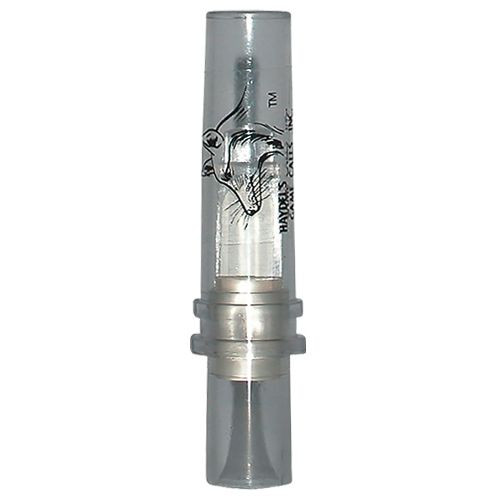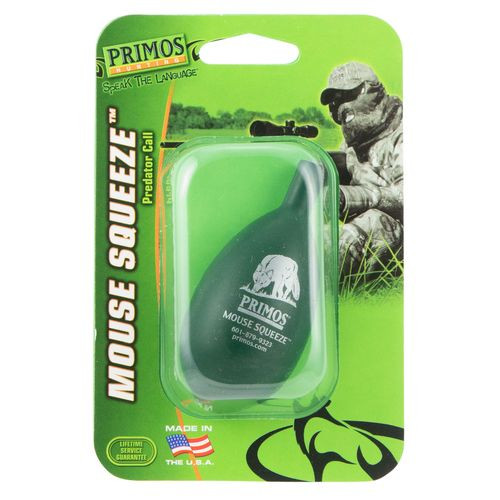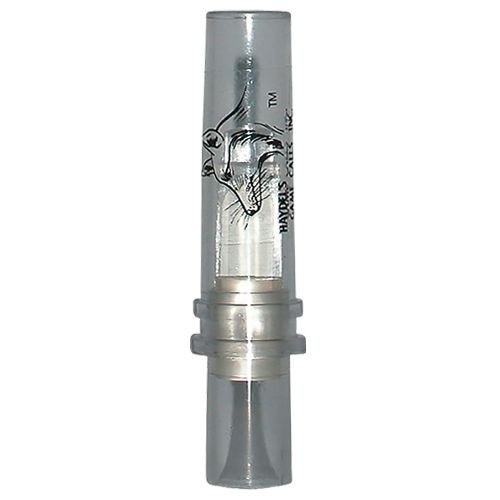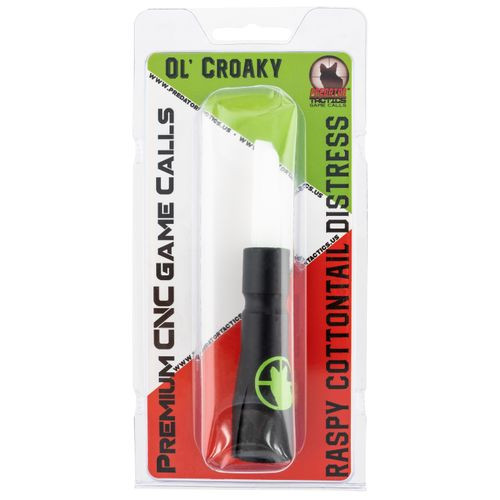Elevate Your Predator Hunting Success with the Primos PS365 Double Cottontail Predator Hand Call
Are you searching for the ultimate tool to significantly enhance your predator hunting success? Do you need a reliable, realistic call that can draw in even the most wary coyotes, bobcats, and foxes from a distance? Whether you're a seasoned predator hunter looking for an edge or a newcomer eager to learn the ropes, mastering the art of calling is paramount. The Primos PS365 Double Cottontail Predator Hand Call is engineered precisely for this purpose, offering unparalleled realism and versatility to help you achieve your hunting goals.
Predator hunting presents unique challenges, often requiring patience, stealth, and, most importantly, the ability to mimic the sounds that trigger a predator's innate hunting instincts. Among these, the distress cry of a cottontail rabbit is universally recognized as one of the most effective lures. It signals an easy meal, compelling predators to investigate quickly. The Primos PS365 stands out as a top-tier choice for replicating this critical sound, offering a compelling solution to the common problem of attracting elusive game.
Unleashing the Power of Sound: Why the Primos PS365 Stands Out
The effectiveness of any predator call hinges on its ability to produce authentic, lifelike sounds that are indistinguishable from real prey. The Primos PS365 Double Cottontail Predator Hand Call is renowned for its exceptional realism, making it a staple in the gear bags of serious predator hunters.
Authenticity of Sound: The Double Cottontail Distress
What makes this call so effective? It’s designed to perfectly replicate the high-pitched, desperate screams of a distressed cottontail rabbit. This is not just any rabbit sound; it's the specific cry that signals a vulnerable, easy target, activating a predator's immediate predatory response. The "Double Cottontail" designation isn't just a name; it signifies the call's capacity to produce a robust, authentic sound profile, often achieved through its unique reed system that creates a full-bodied, multi-tonal distress cry. This allows hunters to vary the intensity and pitch, adding depth and realism to their calling sequences. The sound travels well, cutting through diverse terrains and weather conditions, making it effective for calling across long distances or in dense cover.
Precision Engineering: Design and Materials
The Primos PS365 isn't just about sound; it's about the robust engineering that enables that sound. Crafted with durable materials, it's built to withstand the rigors of outdoor use, from freezing temperatures to wet conditions. This hand call features a precise reed design, often incorporating dual reeds, which is crucial for achieving the nuanced, varied tones necessary for convincing predator calling. The mouthpiece is ergonomically designed for comfort and ease of use, allowing hunters to maintain a firm grip and control over the airflow, which directly impacts the sound produced. This attention to detail in its construction ensures longevity and consistent performance season after season. Hunters often ask, "What makes a hand call durable?" The answer lies in the quality of materials and the simplicity of its mechanical design, both of which are hallmarks of the Primos PS365.
Ease of Use: Designed for All Skill Levels
One of the great advantages of the Primos PS365 is its user-friendly design. Whether you're picking up a predator call for the first time or you're a seasoned expert, you'll find it intuitive to operate. The learning curve is minimal, allowing hunters to quickly develop the muscle memory needed to produce realistic and varied distress sounds. Unlike some electronic calls that require batteries and complex programming, this hand call offers immediate, reliable performance in any situation. Simply put the mouthpiece to your lips and blow, experimenting with different air pressures and hand positions to vary the pitch and volume. This simplicity makes it a favorite among those who prefer a more direct, hands-on approach to calling.
Mastering the Hunt: Real-World Applications and Scenarios
The true value of the Primos PS365 lies in its versatility and effectiveness in real-world hunting scenarios. This call isn't just for attracting one type of animal; its universal distress sound appeals to a wide range of predatory species.
Targeting Wary Predators: Coyotes, Foxes, Bobcats
The primary targets for the Primos PS365 are often coyotes, foxes, and bobcats.
- Coyotes: Known for their intelligence and wariness, coyotes respond strongly to rabbit distress calls. The Primos PS365 can emulate the full spectrum of a dying rabbit's cries, from soft whimpers that draw in close, cautious animals to loud, frantic screams that reach coyotes hundreds of yards away. Many successful coyote hunters will tell you that the key is starting soft and building intensity, and this call allows for that precise control.
- Foxes: Both red and gray foxes are opportunistic hunters highly attuned to small prey distress sounds. The high-pitched nature of the cottontail distress is particularly appealing to foxes, making the PS365 an excellent choice for calling them into range, whether you're hunting in open fields or dense woodlands.
- Bobcats: While often more elusive, bobcats are also attracted to the sound of a struggling rabbit. Patience is key when calling bobcats, and the sustained, realistic sound of the PS365 can keep their attention long enough for them to commit to approaching your position. Hunters frequently ask, "What's the best call for bobcats?" While many factors play a role, a realistic rabbit distress call is consistently high on the list, and the PS365 delivers.
Versatility in the Field: Open Country vs. Dense Cover
The design of the Primos PS365 allows for effective use in diverse hunting environments.
- Open Country: In vast, open landscapes, the call's ability to project sound over long distances is critical. The clear, resonant tones of the Primos PS365 ensure that your call reaches distant predators.
- Dense Cover: When hunting in thick brush or timber, the call's authentic, localized sound can convince a predator that prey is nearby, compelling them to break cover and investigate. The ability to control volume and nuance is especially important here to avoid over-calling.
Beyond the Hunt: Wildlife Observation and Varmint Control
While primarily a hunting tool, the Primos PS365 also serves other purposes. Wildlife enthusiasts can use it to observe natural predator behaviors in a non-intrusive way, attracting animals for photography or study. Additionally, for landowners dealing with nuisance predators affecting livestock or local wildlife populations, the Primos PS365 provides an effective, ethical method for varmint control.
How to Use the Primos PS365 Double Cottontail Call Effectively
Effective use of a hand call is an art form that improves with practice. Here are some guidelines and techniques to maximize your success with the Primos PS365.
Basic Calling Techniques
- Preparation is Key: Always be camouflaged and hidden before you start calling. Predators have excellent sight and smell.
- Start Soft: Begin your calling sequence with soft, pleading cries. This simulates a struggling animal that is just beginning to be in distress.
- Vary Intensity: Gradually increase the volume and intensity of your calls. This mimics the worsening predicament of the prey, increasing the urgency for the predator.
- Short Bursts and Pauses: Don't call continuously. Call in short bursts (15-30 seconds) followed by longer pauses (1-3 minutes). This allows predators time to approach and listen, and it mimics the natural rhythm of an animal in distress.
- Use Your Hands: Cup your hands around the end of the call to direct the sound, or open and close them to create a wah-wah effect, adding further realism.
Advanced Strategies
- Volume Control: Learn to vary your breath pressure to control the volume, from a barely audible whimper to a full, frantic scream. This is crucial for drawing in close, wary animals without spooking them.
- Rhythm Variation: Don't be monotonous. Vary the rhythm of your calls. A dying rabbit doesn't scream at a consistent pace; its cries will be irregular, reflecting struggle and pain.
- Call and Pause: This is perhaps the most important technique. Predators will often approach cautiously, using the pauses in your calling sequence to move closer undetected. During pauses, be absolutely still and scan your surroundings. Many predators are shot during these silent intervals.
- Directional Calling: If possible, move the call slightly to simulate a moving animal. This can be achieved by turning your head slightly or by changing the direction of your hand cupped over the call.
Understanding Predator Reactions
- Approaching Steadily: A predator confidently approaching your position indicates a successful call. Be ready.
- Circling Downwind: Coyotes and foxes will often try to circle downwind to get your scent. Position yourself to account for this.
- Stopping and Looking: If a predator stops and looks directly at your position, it means they've pinpointed the sound source. This is often the best time to take your shot, as they are focused.
- Hesitation: If they hesitate or appear nervous, a quick, sharp series of distress calls can sometimes spur them to commit.
Environmental Considerations
- Wind: Wind can significantly affect sound travel. Always try to call into or across the wind, or at least understand how the wind will carry your sound and your scent.
- Terrain: Obstacles like hills, dense trees, and buildings can block or distort sound. Adjust your calling locations and techniques accordingly.
Optimizing Your Setup: Complementary Gear and Tips
While the Primos PS365 is a powerful tool on its own, integrating it into a comprehensive predator hunting strategy will significantly boost your success rate.
- Camouflage and Scent Control: Predators have incredible senses. Full camouflage, including face paint or a mask, is essential. Scent elimination sprays, specialized clothing, and playing the wind are critical to remaining undetected.
- Scouting and Stand Placement: Before you even blow a call, effective scouting is key. Look for tracks, scat, and other signs of predator activity. Choose stand locations that offer good visibility, allow for a clear shot, and provide cover for yourself. Consider the wind direction relative to your calling location.
- Firearm and Optics: A reliable rifle or shotgun appropriate for predator hunting, coupled with quality optics (scopes, binoculars), will ensure you can accurately engage targets at varying ranges. Many hunters prefer a fast-handling rifle chambered in calibers like .223 Rem, .204 Ruger, or .22-250 Rem.
- Patience and Persistence: Predator hunting is not always fast-paced. Be prepared to sit for extended periods, remaining still and alert. If one stand doesn't produce, move to another location.
The Primos Legacy: A Name You Can Trust
Primos Hunting has long been a leader in the outdoor industry, particularly renowned for its high-quality game calls. When hunters ask, "Which brand of calls can I trust?" Primos consistently comes to mind. Their commitment to realism, durability, and hunter success has earned them a sterling reputation. The PS365 Double Cottontail Predator Hand Call is a testament to this legacy, built on years of experience and feedback from hunters in the field. This brand understands the nuances of animal vocalizations and translates that understanding into calls that perform consistently. Investing in a Primos call means investing in a product designed by hunters, for hunters, ensuring you have the best possible chance of success.
Maintenance and Longevity
To ensure your Primos PS365 Double Cottontail Predator Hand Call performs optimally for years, a little care goes a long way.
- Keep it Clean: After each use, especially if used in damp conditions, gently wipe down the call. Check the reeds for any debris that might affect the sound. For deeper cleaning, follow manufacturer instructions, which usually involve rinsing with water and allowing to air dry.
- Store Properly: Store your call in a dry, cool place, away from direct sunlight or extreme temperatures. Many hunters keep their calls in a protective pouch or case to prevent damage.
- Inspect Reeds: Periodically inspect the reeds for wear or damage. While Primos calls are durable, reeds can wear over time with heavy use. Replacement reeds are typically available if needed.
By following these simple steps, you can ensure that your Primos PS365 remains a reliable and effective tool for countless hunting seasons to come.
In conclusion, the Primos PS365 Double Cottontail Predator Hand Call is more than just a hunting accessory; it's a vital component of any successful predator hunting strategy. Its unmatched realism, durable construction, and ease of use make it an indispensable tool for attracting coyotes, foxes, bobcats, and other predators. Whether you're calling them in for ethical harvest or for observation, this call provides the compelling sound needed to pique their interest and bring them into range. Equip yourself with the trusted performance of Primos and elevate your predator hunting game. This essential piece of gear, known for its effectiveness and reliability, is readily available to help you achieve your next successful hunt.
Product Specifications
| Feature | Description |
|---|---|
| Model | Primos PS365 Double Cottontail |
| Type | Hand Call (Mouth Blown) |
| Sound | Realistic Cottontail Rabbit Distress |
| Primary Prey | Coyotes, Foxes, Bobcats, other small predators |
| Material | Durable, high-quality composite |
| UPC | 010135003657 |
| Availability | Available at DEGuns.com |











